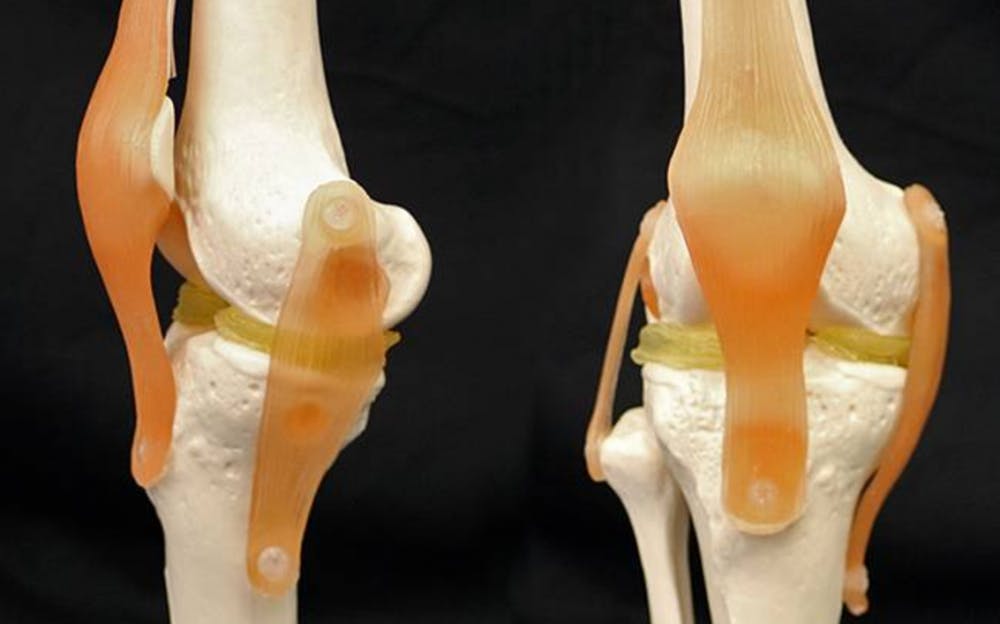Research using new nanomaterials has led to the development of devices with practical uses, such as a 3D-printed knee replacement.
A team of scientists in the lab of Benjamin Wiley, associate professor of chemistry and assistant professor of mechanical engineering and materials science, has recently developed a hydrogel-based material that is the first to match the remarkable strength and elasticity of human cartilage while also being biologically compatible with the surrounding tissue. This technology may one day allow surgeons to 3D print replacement menisci—the cartilage found in knees and wrists—that are custom-shaped to each patient’s anatomy.
“No one had [3D]-printed a meniscus as strong as the cartilage normally is strong in the body,” Wiley said.
The biggest challenge of the study was designing a gel that could be printed at room temperature with relatively simple equipment that matched the mechanical properties of cartilage in the meniscus, he noted.
He explained that his team modified hydrogel material—named for its ability to hold large amounts of water—with nano-clay to match the strength of the material.
Wiley said that the most common treatment for meniscus tears today is to simply have it removed, which means the patient would no longer have any shock absorber in his or her knee.
Wiley explained that one potential replacement for a human meniscus is the NUSurface Meniscus Implant, which has a non-porous structure that does not stimulate tissue generation. He added that this can cause wear and tear over time.
“When you’re a sports player when you’re young, you want to be able to keep playing, and so you want to be able to put something back in there that’s just like the original [meniscus],” he said.
Wiley and his team have already had at least a few orthopedic surgeons reach out to them, including one here at Duke and another in the United Kingdom. The surgeons wanted to know how close Wiley thinks this particular technology is to being implemented in hospitals.
However, Wiley noted that prospective meniscus surgery patients should not wait for the new technology.
“This is probably one or two decades away,” he said. “If you’re thinking you should wait one or two more years before your surgery, you should get it [now].”
The team's work in nanomaterials also recently presented applications outside of medicine and healthcare, demonstrating the first fully-printable digital memory.
The researchers developed a new nanomaterial made of copper nanowires, which they say can be used to manufacture simple electronics such as radio frequency identification tags to prevent shoplifting. This “spray-on” memory could be used to build electronic devices directly on flexible substances such as plastic, paper or fabric.
Although the 3D-printing hydrogel technology is not yet available for practical applications, the spray-on memory technology has already been demonstrated in action. Chemistry graduate student and first author of the study Matthew Catenacci connected the device to a circuit containing 4 LED lights and was able to program 16 different patterns of illuminated lights.
In a real-world application, these patterns could be programmed to correspond to any display symbol. It takes approximately three microseconds to alternate between different patterns, a speed which rivals that of most flash drives.
The technology is based on copper nanowires, which can be modified into printable electronics for practical applications, Catenacci explained.
He also reflected on the potential impact of his team’s discovery.
"[This device] opens up avenues toward rapid prototyping of memories using printed memory, and this can also store and log data over time," he said. "Then, if you have a printed transmitter, you can quickly log the data and send it out to its destination."
Catenacci noted that he is looking forward to "just seeing how the public will like [spray-on memory], how development and printer companies will want to use this technology to print general devices using basic memory principles.”
Editor's note: This article has been updated to correct an inaccurate quote. Wiley stated that the NUSurface Meniscus Implant had been approved. It is still undergoing clinical trials. The Chronicle regrets the error.
Get The Chronicle straight to your inbox
Signup for our weekly newsletter. Cancel at any time.

